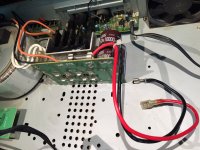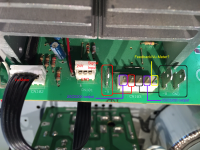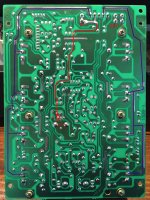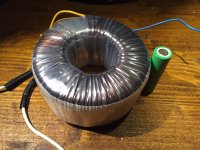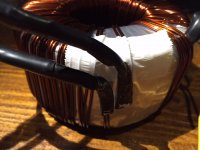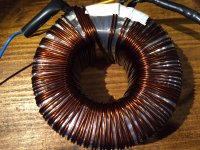As overbuilt as that amplifier appears to be, I'll bet you could just run a 4 ohm subwoofer with it like it is. The only problem is the transformer. It may be ok down to 60, 50, or even 40 Hz. I'll bet it won't do 20 and would start having trouble at 30. And it gets worse as you go lower impedance.
Not at all, as it's transformer output there's no requirement for bridging at
all - and even assuming it was bridged, that's still no where near it's rated
power without a low to high impedance output transformer (assuming
bridging, and a 4 ohm load, you'd only get about 100W or so).
Certainly the output diagram the OP has posted shows no indication it might be bridged.
I'm with indianajo, it's worth $25 just for the heatsink
Hi,
If the supply is single rail the amp needs an
output capacitor, there is no sign of one at all.
Far too many contradictions here.
Reviewing the thread, I think its dual rail, not
single, so my bridging comments don't apply.
rgds, sreten.
Last edited:
I don't proud myself with electronics knowledge, but I think I can discern one rail from two rails. If you look closely in the photo, you can see only two wires going from the PS board to the amp board.
And I measured those, 34VDC or thereabouts. Also I measured the transformer's AC voltage at 25VAC if I remember correctly.
If I find the time I will post some more detailed pictures. The only "secondary" voltage is a 24VDC low power output at the back of the unit for PA applications, but that's derived from the main output of the transformer.
Also, I tend to trust my DMM in showing voltages, I just checked it few days ago after replacing it's battery.
Edit: forgot to mention that the transformer has only and only two wires on it's secondary, so one main voltage of 25V. Again, there are only two wires, one red, one black going into the amp board. There's a yellow wire going from the ps board to the back of the unit for external connections (24V).
And I measured those, 34VDC or thereabouts. Also I measured the transformer's AC voltage at 25VAC if I remember correctly.
If I find the time I will post some more detailed pictures. The only "secondary" voltage is a 24VDC low power output at the back of the unit for PA applications, but that's derived from the main output of the transformer.
Also, I tend to trust my DMM in showing voltages, I just checked it few days ago after replacing it's battery.
Edit: forgot to mention that the transformer has only and only two wires on it's secondary, so one main voltage of 25V. Again, there are only two wires, one red, one black going into the amp board. There's a yellow wire going from the ps board to the back of the unit for external connections (24V).
Last edited:
But regardless, you're looking at a complete rebuild of the amp, including the PSU - is it worth it?.
Why can't you just use the amp with the output transformer?, doesn't it have a 4 ohm output?, if not get yourself a new 8 ohm subwoofer.
Doesn't have a 4ohm output, only 8 ohm. I was thinking that using it with a 4ohm subwoofer, that would be bad news for the output transformer.
I already have the subwoofer, that I built, and I wouldn't want to make another one. I will have to find a suitable amp for it.
But it's not a priority, don't need it that much, just that I notice it's here from time to time and I'd like to have the option to use it
For me, the worst part of building an amplifier is finding a suitable case, mounting everything inside, holes, threads, then the price of the transformer, connectors etc. A whole lot of hassle after I've got the PCB done. I was hoping I can get away with only making the circuit.
Right now I'm working on putting my raspberry wireless system in a box, and I am designing the back plate holes and trying to convince ebay sellers to cut them out for me before I buy the case
So you can see why I preferred to just make another PS/output pcb and keep the transformer/case.
@sreten
I took some pictures and noted some details on them. I think you can better tell what's happening this way.
Attachments
I agree, the creativity of diyaudio is the circuit design and construction. Shearing aluminum or steel sheet, bending it in a press brake, welding things together, all take so much huge equipment and space, leave that to the pros. I don't want a garage full of those tools. I'm stuffing amp/mixer/sound shaper designs in boxes salvaged from AC motor drives, which have a heat sink, and steel file boxes, which don't. I can cut big holes for connectors, square or round, with a hack saw, and drilling shaft and indicator holes requires only a vise and drill motor. There are always amps with short lived or bad sounding circuit designs available for cheap, or ones like this one designed for bad sound (voice only, 70v, maybe musak) distributed over a wide area. You can salvage heat sink, case, the 2SC5200's, maybe some filter caps. New transformer, new circuit, a whole new amp, a whole new level of sound quality. Have fun.For me, the worst part of building an amplifier is finding a suitable case, mounting everything inside, holes, threads, then the price of the transformer, connectors etc. A whole lot of hassle after I've got the PCB done. I was hoping I can get away with only making the circuit.
So you can see why I preferred to just make another PS/output pcb and keep the transformer/case.
I got an idea - drop its power supply voltage a little and just run it on 4 ohms. A few (maybe 20) turns of #14 THHN on the trafo, and put in series with the primary. Whatever it takes to get the B+ down to maybe 28V unloaded. The amp is probabaly over built enough that you don't have to do this (might be 300+ watts in 4 ohms) to run safely, but it would bring you further down the OPT BH curve and let it go lower in frequency before it saturates and distorts. Up size the coupling caps, and presto - it runs down to 20 Hz.
Judging from the size of the power trafo and heat sinks, it's probabaly one of those amps that's rated for emergency signal applications - which require being able to put out anywhere up to rated power at full sine wave for 8 hours. Even at half rated inpedance it would still outlast most modern bar band PA amps before thermalling. Ever see the size of the heat sinks in the GX3? It will make you sick. You've got a LOT more there.
Judging from the size of the power trafo and heat sinks, it's probabaly one of those amps that's rated for emergency signal applications - which require being able to put out anywhere up to rated power at full sine wave for 8 hours. Even at half rated inpedance it would still outlast most modern bar band PA amps before thermalling. Ever see the size of the heat sinks in the GX3? It will make you sick. You've got a LOT more there.
It's a center tapped OPT, kind of like a tube amp. Except that it is step up, not step down.
Yes, that's clear from the latest pictures he posted - pretty crude and nasty
Does make it far less use for any other purpose though - as I said before, his best bet is to change the impedance of the speaker in his subwoofer.
I got an idea - drop its power supply voltage a little and just run it on 4 ohms. A few (maybe 20) turns of #14 THHN on the trafo, and put in series with the primary. Whatever it takes to get the B+ down to maybe 28V unloaded. The amp is probabaly over built enough that you don't have to do this (might be 300+ watts in 4 ohms) to run safely, but it would bring you further down the OPT BH curve and let it go lower in frequency before it saturates and distorts. Up size the coupling caps, and presto - it runs down to 20 Hz.
Judging from the size of the power trafo and heat sinks, it's probabaly one of those amps that's rated for emergency signal applications - which require being able to put out anywhere up to rated power at full sine wave for 8 hours. Even at half rated inpedance it would still outlast most modern bar band PA amps before thermalling. Ever see the size of the heat sinks in the GX3? It will make you sick. You've got a LOT more there.
Nah, I mainly try the hard way so I learn stuff on the way.
I just bought it and now trying to see what's to be done with the transformer.
Seems like the secondary is only one layer and a quarter or so. Wouldn't be much work, just need to try and figure out how to calculate what's happening. I presume I can keep the same wire gauge as I'm not going for more amps, and the current will fall anyway.
The battery in the photo is a 18650 for size reference.
I see that they used two wires in parallel when winding. Is this for more current capability keeping the wire thinner so it's easier to wind?
There are 63 turns of the secondary. The diameter of the wire is 1.5mm. Would it be ok to go 1.25mm diameter in two wires? I found 1.5mm but the spool is only 34meters, 1.25mm is about 47 meters, and 1.00mm is about 70m.
Attachments
Get the 1.5 mm and add some more turns to what's already on there. Solder (and heat shrink) to one end of both, and add some more bifilar turns. I'd put a layer of tape between layers of turns just to be safe. Then put them in series once you get it to about 42-0-42. It might be too tight to use a jig, but another 50 or 60 turns by hand isn't THAT hard.
Hi,
If the supply is single rail the amp needs an
output capacitor, there is no sign of one at all.
Far too many contradictions here.
Reviewing the thread, I think its dual rail, not
single, so my bridging comments don't apply.
rgds, sreten.
You don't get it, do you?It can't be single rail driving a transformer without a big output cap.
rgds, sreten.
The OP posted the actual schematic on post #10
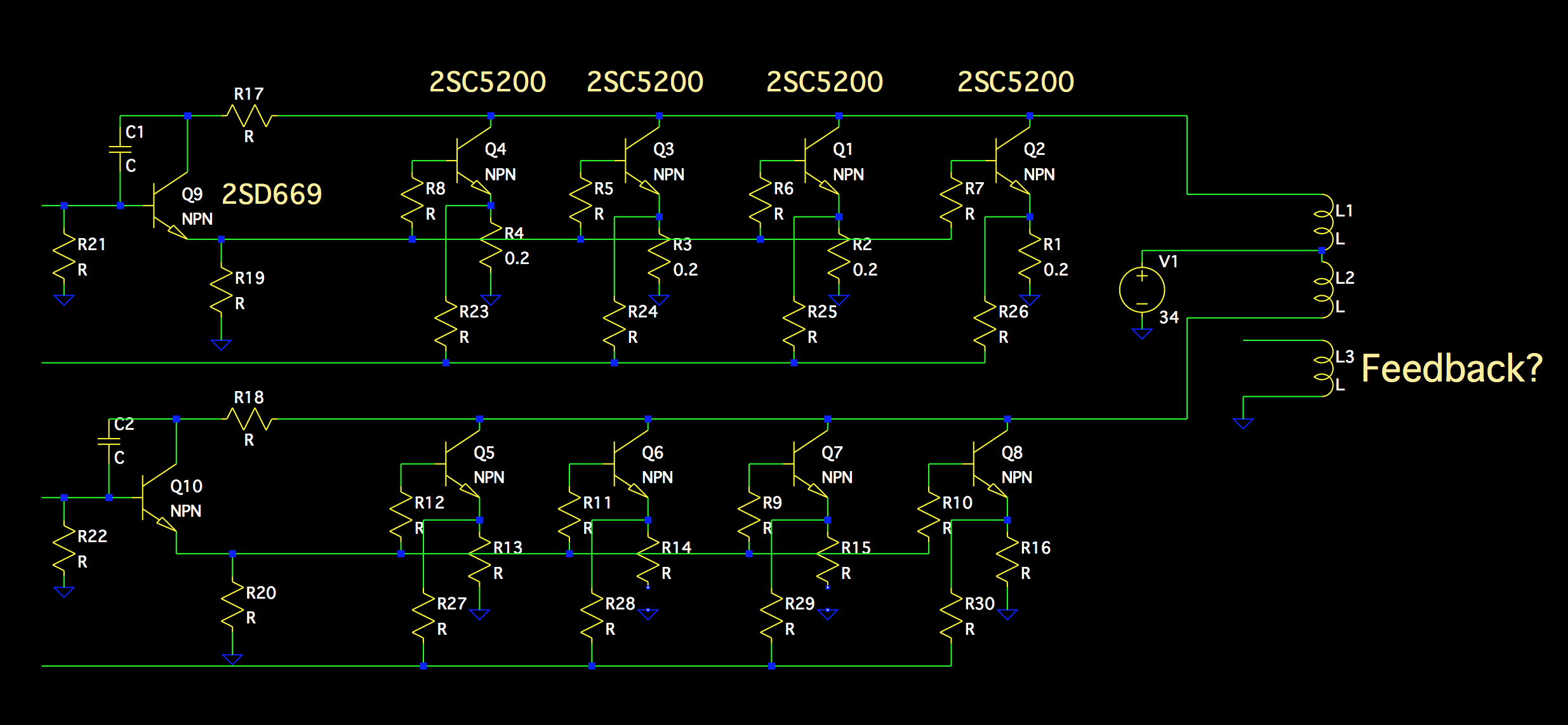
Care to share where would you add the Output Cap?
FWIW 34V single supply is a popular choice in this kind of big PA amps: the amp puts out full power with its mains PSU, and in emergencies it can be powered with two common 12V car batteries in series, available everywhere, and still provide a lot of useful audio power.
A popular brand doing exactly that, the very well made Indian Ahuja amps:

Notice the 24V binding posts under the IEC socket.
Detailed Description
350 watt 100V 5 Zone Mixer / Amplifier. 230V AC / DC 24V
Brief
The TI-350S mixer amplifier is a 5 zone, 3RU mixer public address amplifier with 70V, 100V and 4-16ohm speaker outputs and 4 universal combined mic inputs (1/4" phone jack and XLR). 2 line inputs via dual RCA type are also provided to make this one of the most flexible PA amplifiers in the world
So popular that others follow their lead (such as the above mentioned Philips amp).
Personally, I'd use it as is.
Fully stripping and rebuilding it is a lot of work.
Pity it's not exactly suited as a *subwoofer* amp.
If anything, I'd rather build one from the ground up.
- Status
- This old topic is closed. If you want to reopen this topic, contact a moderator using the "Report Post" button.
- Home
- Amplifiers
- Solid State
- PA mono amplifier, want to remove output transformer
